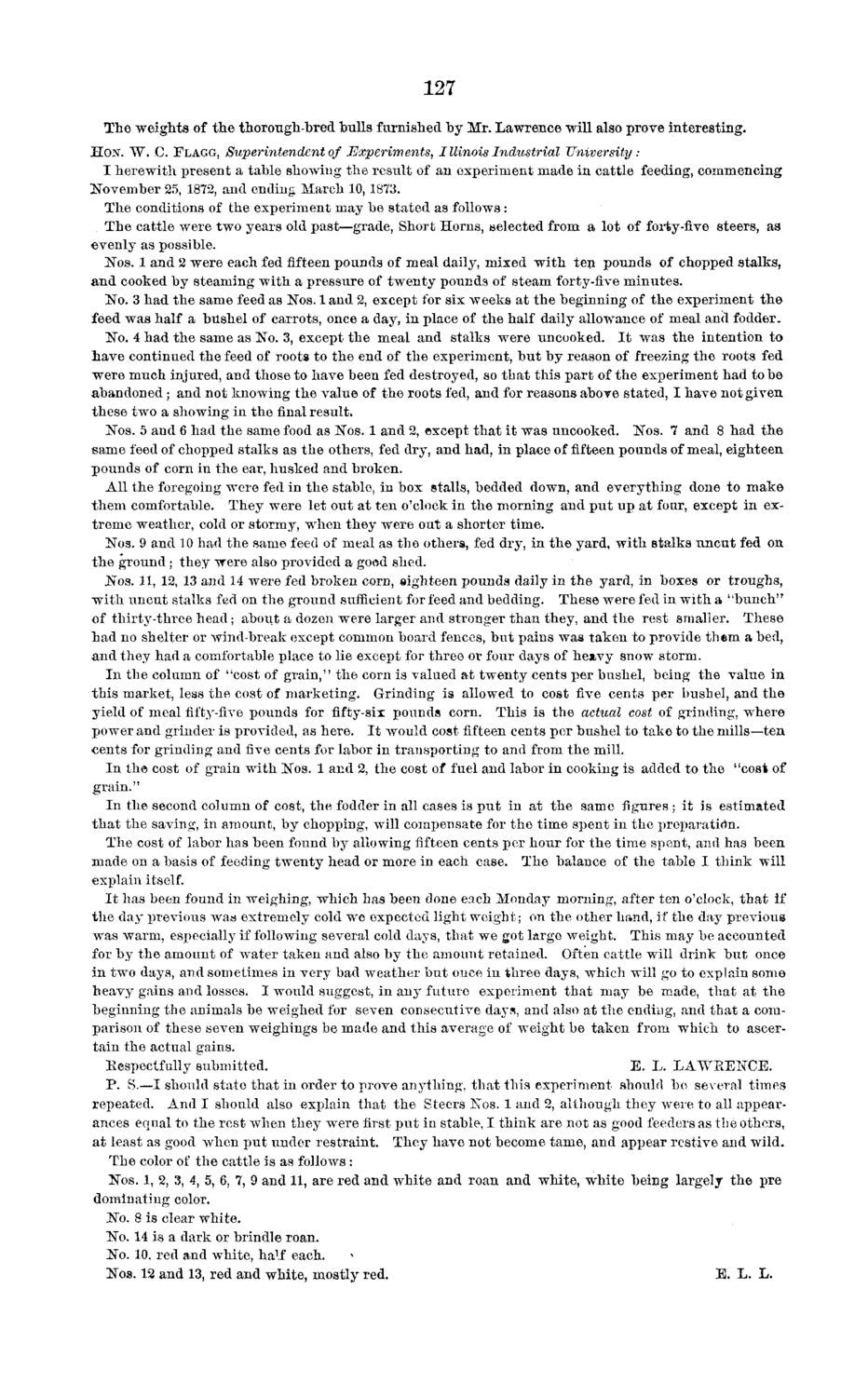| |
| |
Caption: Board of Trustees Minutes - 1873
This is a reduced-resolution page image for fast online browsing.

EXTRACTED TEXT FROM PAGE:
127 The weights of the thoroughbred bulls furnished by Mr. Lawrence will also prove interesting. HON. W. C. FLAGG, Superintendent of Experiments, Illinois Industrial University : I herewith present a table showing the result of an experiment made in cattle feeding, commencing November 25, 1872, and ending March 10, 1873. The conditions of the experiment may be stated as follows : The cattle were two years old past—grade, Short Horns, selected from a lot of forty-five steers, as evenly as possible. Nos. 1 and 2 were each fed fifteen pounds of meal daily, mixed with ten pounds of chopped stalks, and cooked by steaming with a pressure of twenty pounds of steam forty-five minutes. No. 3 had the same feed as Nos. 1 and 2, except for six weeks at the beginning of the experiment the feed was half a bushel of carrots, once a day, in place of the half daily allowance of meal and fodder. No. 4 had the same as No. 3, except the meal and stalks were uncooked. I t was the intention to have continued the feed of roots to the end of the experiment, but by reason of freezing the roots fed were much injured, and those to have been fed destroyed, so that this part of the experiment had to be abandoned; and not knowing the value of the roots fed, and for reasons above stated, I have not given these two a showing in the final result. Nos. 5 and 6 had the same food as Nos. 1 and 2, except that it was uncooked. Nos. 7 and 8 had the same feed of chopped stalks as the others, fed dry, and had, in place of fifteen pounds of meal, eighteen pounds of corn in the ear, husked and broken. All the foregoing were fed in the stable, in box stalls, bedded down, and everything done to make them comfortable. They were let out at ten o'clock in the morning and put up at four, except in extreme weather, cold or stormy, when they were out a shorter time. Nos. 9 and 10 had the same feed of meal as the others, fed dry, in the yard, with stalks uncut fed on the ground; they were also provided a good shed. Nos. 11, 12, 13 and 14 were fed broken corn, eighteen pounds daily in the yard, in boxes or troughs, with uncut stalks fed on the ground sufficient for feed and bedding. These were fed in with a "bunch" of thirty-three head; about a dozen were larger and stronger than they, and the rest smaller. These had no shelter or wind-break except common board fences, but pains was taken to provide them a bed, and they had a comfortable place to lie except for three or four days of heavy snow storm. In the column of "cost of grain," the corn is valued at twenty cents per bushel, being the value in this market, less the cost of marketing. Grinding is allowed to cost five cents per bushel, and the yield of meal fifty-five pounds for fifty-six pounds corn. This is the actual cost of grinding, where power and grinder is provided, as here. I t Avould cost fifteen cents per bushel to take to the mills—ten cents for grinding and five cents for labor in transporting to and from the mill. In the cost of grain with Nos. 1 and 2, the cost of fuel and labor in cooking is added to the "cost of grain." In the second column of cost, the fodder in all cases is put in at the same figures ; it is estimated that the saving, in amount, by chopping, will compensate for the time spent in the preparation. The cost of labor has been found by allowing fifteen cents per hour for the time spent, and has been made on a basis of feeding twenty head or more in each case. The balance of the table I think will explain itself. I t has been found in weighing, which has been done each Monday morning, after ten o'clock, that if the day previous was extremely cold we expected light weight; on the other hand, if the day previous was warm, especially if following several cold days, that we got large weight. This may be accounted for by the amount of water taken and also by the amount retained. Often cattle will drink but once in two days, and sometimes in very bad weather but once in three days, which will go to explain some heavy gains and losses. I would suggest, in any future experiment that may be made, that at the beginning the animals be weighed for seven consecutive days, and also at the ending, and that a comparison of these seven weighings be made and this average of weight be taken from which to ascertain the actual gains. Eespectfully submitted. E. L. LAWEENCE. P. S.—I should state that in order to prove anything, that this experiment should be several times repeated. And I should also exx)lain that the Steers Nos. 1 and 2, although they were to all appearances equal to the rest when they were first put in stable, I think are not as good feeders as the others, at least as good when put under restraint. They have not become tame, and appear restive and wild. The color of the cattle is as follows : Nos. 1, 2, 3, 4, 5, 6, 7, 9 and 11, are red and white and roan and white, white being largely the pre dominating color. No. 8 is clear white. No. 14 is a dark or brindle roan. No. 10, red and white, half each. Nos. 12 and 13, red and white, mostly red. E. L. L.
| |